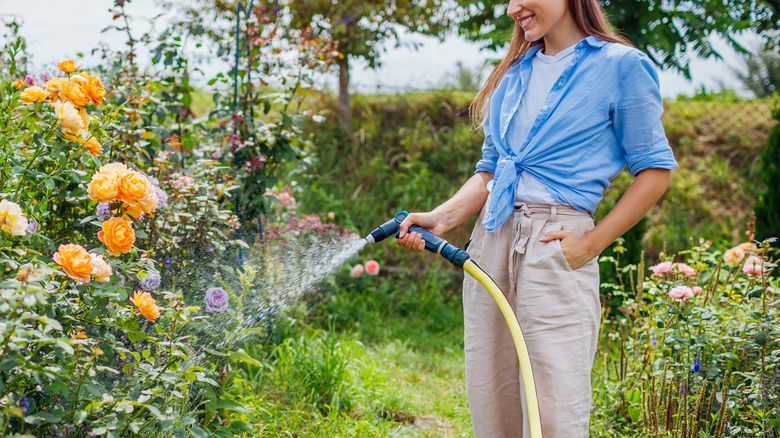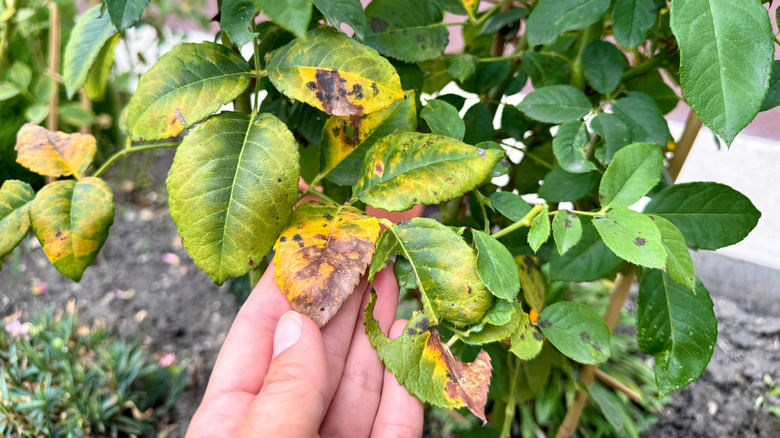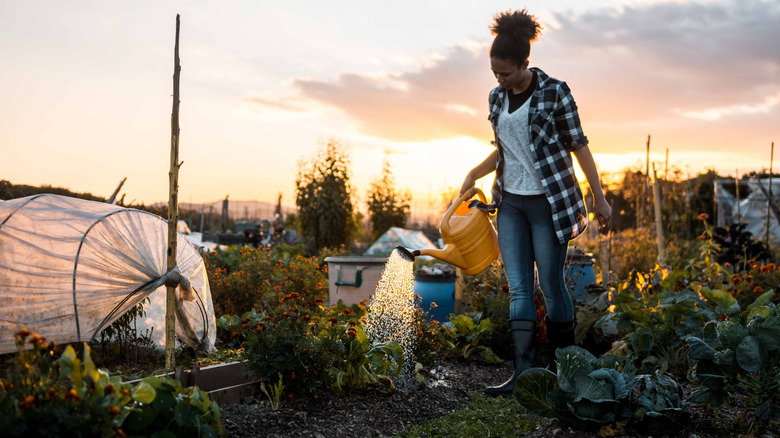Does The Time Of Day Matter When Watering Your Plants? Here's What We Found
You may have heard that morning is the best time of day to water a lawn and other plants in your garden. But how much does timing matter? As long as you're meeting the plant's irrigation needs, does the time of day make that much of a difference? Unfortunately, the answer is yes.
The reason many gardeners recommend watering your garden early in the morning is because this is the perfect window where the risk of disease and the risk of water loss through evaporation is lowest. That doesn't mean watering at any other time of day is a total waste. But it does mean you'll be exposing your garden to threats that a morning watering schedule would avoid. The easiest way to make sure your garden is watered at the perfect time of day is to install an irrigation system with a timer to automate your plant watering.
If you don't already have a system and don't want to install one, you'll need to do the best you can with the time and resources you have. That may mean watering at a less than ideal time of day. So, to keep plants happy and healthy, it helps to understand exactly why time of day matters and what you can do to minimize the unique risks that come with watering at different times during the day.
Why the time of day matters when watering your plants
The time of day influences the amount of water plants actually get from irrigation and their risk of disease. Evaporation rates increase with temperature, but losses become most dramatic above 86 degrees Fahrenheit (30 degrees Celsius). Humidity counteracts this effect. Air can only hold so much water. When it reaches 100% relative humidity, water can no longer evaporate. Check your daily humidity. The closer it is to 100%, the less water you'll lose to evaporation, regardless of temperature.
Conversely, wind increases evaporation rates by pushing humid air away, essentially keeping the area above your soil always dry enough to absorb more water. It can also cause water loss by blowing water droplets away before they even land on the soil. Since early morning hours tend to be the coolest and calmest part of the day, water loss is lowest. At the same time, temperatures gradually rise from this point on, allowing droplets that hit the leaves to dry off quickly. So, the roots are getting the moisture they need without keeping the leaves damp for prolonged periods.
Mild temperatures and dampness are a recipe for disease. While different bacteria and fungal diseases thrive at different temperatures, many have a maximum tolerance of around 80 degrees Fahrenheit. By watering at night, you're creating the prime environment for disease, as the leaves and soil remain damp through the night while temperatures are milder but still warm. In the morning, temperatures might still be right for disease, but the plant is less likely to stay wet long enough for an infection to take hold.
Tips for optimizing your watering schedule
If early morning watering isn't realistic for your schedule and you can't install an automated irrigation system, you can still maintain a healthy garden by finding the second-best time to water. In warmer climates, where peak midday temperatures regularly exceed 86 degrees Fahrenheit, water loss is likely a bigger concern than disease. Because of this, late evening irrigation is preferable. You'll minimize water loss, but there's still probably enough radiant heat in the ground to dry off the leaves quickly. So focus on watering plants deeply but infrequently so your plants aren't soaked every night of the week.
For gardeners in cooler climates, the afternoon might be your second best time of day for watering. Your plants still have enough daylight left to dry off before temperatures cool again at night. You'll still probably lose more water to evaporation than you would if watering early in the morning, but that's preferable to the risk of disease your plants face by staying wet all night after an evening watering. Just remember to factor that loss in by watering each plant a little longer than you normally would. It's also a good idea to just water at the very soil level to avoid getting too much liquid on the leaves.


